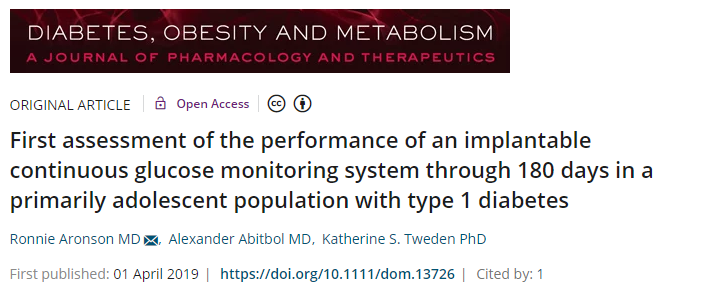Optimal insulin correction factor in post-high-intensity exercise hyperglycemia in adults with type 1 diabetes: The FIT Study

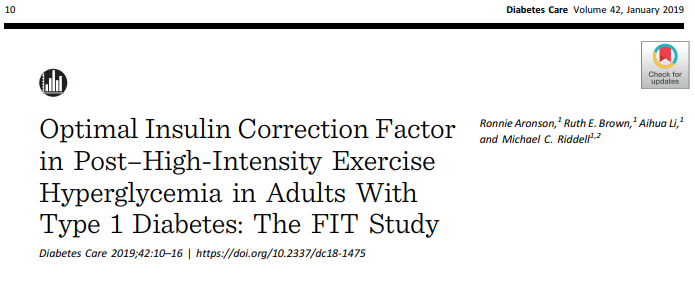
High-Intensity Interval Training (HIIT) is very popular activity but has been poorly understood. Where most exercise leads to hypoglycemia (low blood sugar), HIIT often leads to dramatic hyperglycemia (high blood sugar).
We created a HIIT experience in the lab, as commonly performed in real world settings, and reproduced the post-HIIT hyperglycemia often experienced by people with T1D. We then assessed the impact of varying correction doses (either none or 50%, 100%, or 150%) using an individual’s own insulin correction factor (ICF). Immediate post-exercise hyperglycemia occurred consistently in 90% of our exercise sessions. And of the various treatment options, the best glycemic results came with the full correction dose (100%) or with the extra dosing (150%), with very minimal hypoglycemia.
Reproducibility in the cardiometabolic responses to high-intensity interval exercise in adults with type 1 diabetes
Exercise classically leads to hypoglycemia concerns (low blood sugar) but high-Intensity Interval Training (HIIT) often leads to dramatic hyperglycemia (high blood sugar). We were able to demonstrate definitively, for the first time, that the hyperglycemia effect is very common (90% of sessions) and very consistent in repeated exercise.
The study showed that although there are inter-individual differences, there is a high within-patient reproducibility in the hyperglycemia response to multiple HIIT sessions, when performed in a fasted state. The rise in plasma glucose is most associated with the individual rise in circulating lactate during the activity. This large and consistent glucose increase supports the notion that individualized insulin strategies are needed to correct the hyperglycemia of HIIT in active individuals with T1D.
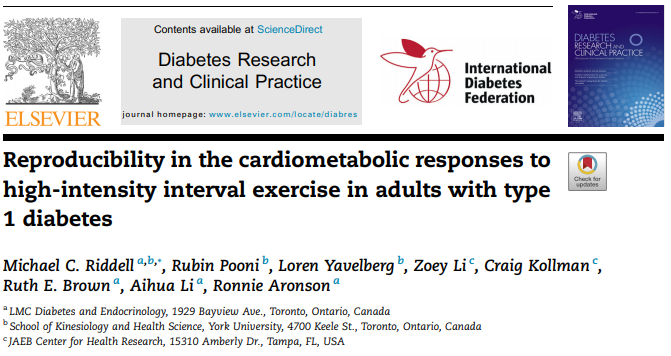

Time lag and accuracy of continuous glucose monitoring during high intensity interval training in adults with type 1 diabetes
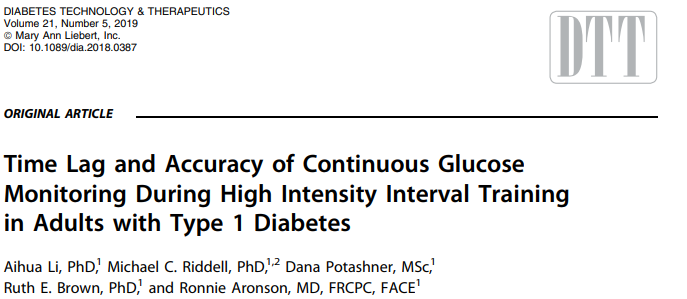

For individuals with type 1 diabetes, glycemic control can be observed through real-time continuous glucose monitoring (rtCGM). This study investigated accuracy of the rtCGM during exercise – particularly the highly popular activity called high intensity interval training (HIIT) within individuals with type 1 diabetes and found that accuracy during HIIT and in early recovery can be impaired. Specifically, we found a lag time during HIIT activity of 34 minutes between the CGM measured glucose and the participants’ actual glucose. The lag leads to an underestimate of actual glucose of by ~2 mmol/L (35.3 mg/dL) during the glucose rise of HIIT activity.
Real-world health outcomes of insulin glargine 300 U/mL vs insulin glargine 100 U/mL in adults with type 1 and type 2 diabetes in the Canadian LMC diabetes patient registry: The REALITY study
This retrospective study focused on the real-world clinical outcomes of individuals with type 1 diabetes and type 2 diabetes who initiated either insulin glargine 300 U/mL or insulin glargine 100 U/mL. In both an insulin naïve cohort and a basal insulin switch cohort, patients initiating insulin glargine 300 U/mL or insulin glargine 100 U/mL had similar 3 to 6-month reductions in HbA1c, and a similar change in weight. Patients with type 1 diabetes and type 2 diabetes who switched from insulin glargine 100 U/mL to insulin glargine 300 U/mL had a significant reduction in HbA1c with no change in weight or insulin dose.
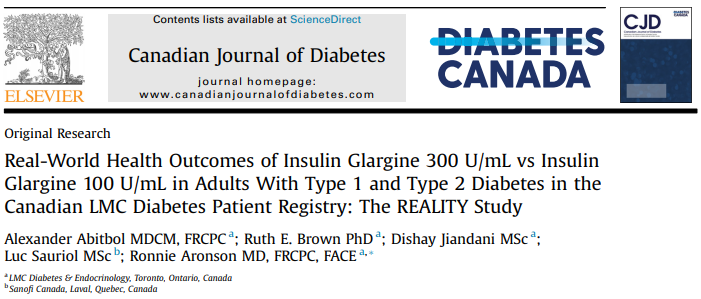

Optimizing diabetes self-management using the novel skills, confidence and preparedness index (SCPI)




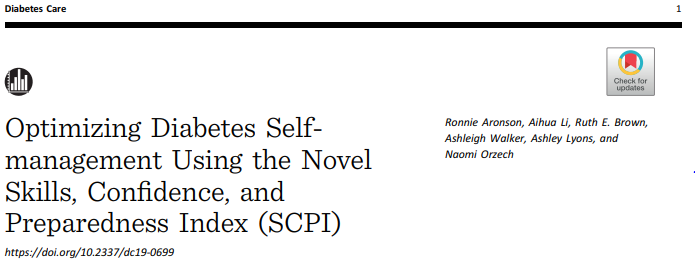

The electronic version of the SCPI (Skills, Confidence, and Preparedness Index) was designed to provide immediate feedback to healthcare providers to encourage individualization in patient education. An ideal questionnaire would be highly reliable, would be related to an important diabetes outcome, such as glycemic control, , and would be responsive to an intervention such as patient education. The study found the SCPI tool to have a high validity, consistency, and reliability. Scores on the SCPI tool were related to glycemia (HbA1c) and in participants who underwent further teaching, the improvement in HbA1c correlated with the improvement in the SCPI score.
Patient reported outcomes following initiation of Glucagon-like peptide-1 Receptor agonists in patients with type 2 Diabetes in a specialist endocrinology practice of the LMC diabetes registry: The PROGRESS-Diabetes study
This prospective, observational study compared patient-reported outcomes, including diabetes medication satisfaction and medication adherence, as well as important clinical outcomes, in patients with type 2 diabetes who started a GLP-1 receptor agonist (dulaglutide or liraglutide) as part of usual clinical therapy.
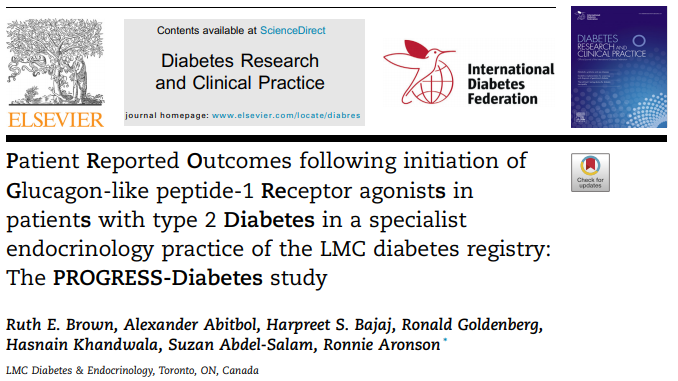

Paradoxical rise in hypoglycemia symptoms with development of hyperglycemia during high intensity interval training in type 1 diabetes




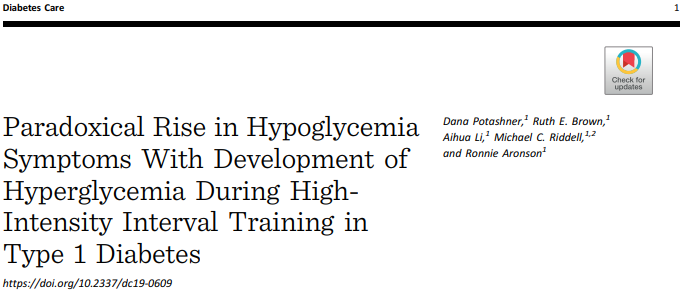

This study focused on the reliability of the self perception of glycemia, including hypoglycemia symptoms and self-estimated blood glucose levels, during high-intensity interval training (HIIT) within individuals with type 1 diabetes. Despite progressing hyperglycemia during HIIT, individuals experienced increased symptoms of hypoglycemia, and tended to underestimate their blood glucose level.
First assessment of the performance of an implantable continuous glucose monitoring system through 180 days in a primarily adolescent population with type 1 diabetes
This study primarily looked at an adolescent population with type 1 diabetes for 180 days to investigate the performance of the Eversense XL implantable continuous glucose monitoring system.
